Chapter 6: Temporal-Difference Learning
Jake Gunther
2019/13/12
Temporal-Difference Learning
Background
- Combines MC and DP ideas
- Learns from experience like MC
- Bootstraps like DP
TD Prediction
MC Prediction
\[ V(S_t) \leftarrow V(S_t) + \alpha[G_t-V(S_t)] \]
- Constant \(\alpha\) suitable for nonstationary env.
- MC updates at end of episode when \(G_t\) known
TD Prediction
\[ V(S_t) \leftarrow V(S_t) + \alpha[R_{t+1} + \gamma V(S_{t+1}) -V(S_t)] \]
- Uses idea that \(V(S_t) = E[G_t|S_t]\) and \(G_t = R_{t+1} + \gamma G_{t+1}\)
- Updates immediately on transition to \(S_{t+1}\) when \(R_{t+1}\) is received
- Does not wait till end of episode
- Called one-step TD or \(TD(0)\)
TD Prediction Algorithm
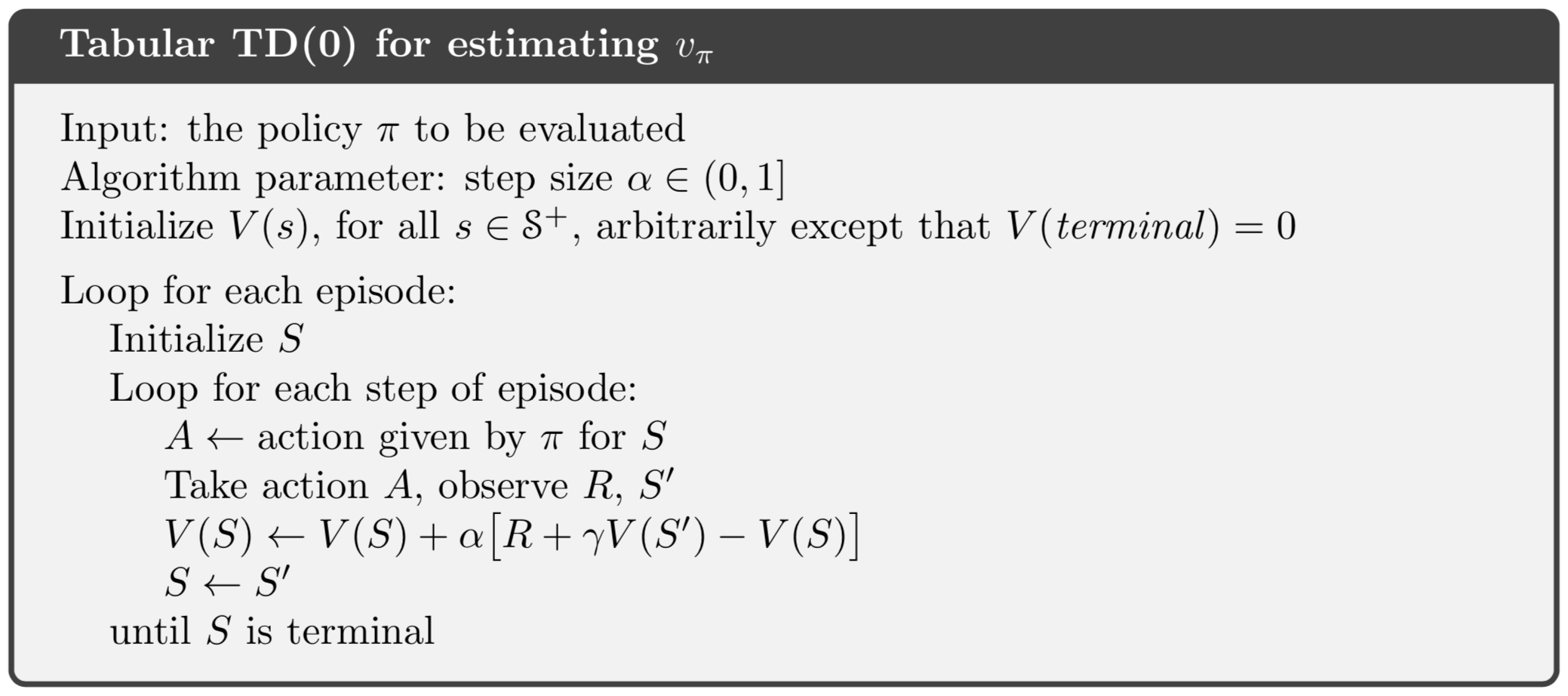
TD(0) Bootstraps
- TD estimate depends on previously estimated value
- Also note relation between MC and TD targets
\[ \begin{alignat}{2} v_\pi(s) &= E_\pi[G_t |S_t=s] \quad & &(\text{MC target}) \\ &= E_\pi[R_{t+1}+ \gamma G_t |S_t=s] \\ &= E_\pi[R_{t+1} + \gamma v_\pi(S_{t+1}) |S_t=s] \quad & &(\text{TD target}) \end{alignat} \]
- TD combines sampling of MC and bootstrap of DP
TD(0) Backup Diagram
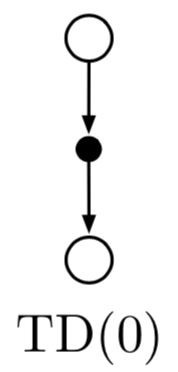
- TD and MC use sample updates
- DP uses expected updates
TD Advantages
TD Advantages
- TD bootstraps (like DP, MC doesn’t)
- TD does not requires \(p(s',r|s,a)\) (DP requires it)
- TD is online and incremental (MC updates after episodes)
- TD applies to continuing tasks (MC oriented to episodic tasks)
- TD learns from every transition (MC ignores exploratory episodes)
TD(0) Convergence
For stationary MDP and fixed policy \(\pi\), TD prediction (learning \(v_\pi\))
- Convergence in mean to \(v_\pi\) with \(\alpha\)=constant
- Convergence with prob. 1 with decreasing \(\alpha\)
In practice, TD methods converge faster than constant-\(\alpha\) MC on stochastic tasks
Example 6.2 Random Walk

Homework: Do exercises 6.3 and 6.4 and 6.6.
Batch Updates
Batch Update Algorithm
- Finite amount of experience, say, \(N\) episodes
- TD increments computed for every time step
- Value function estimate \(V\) changed only once by sum of increments
- Repeat, process all experience again, etc.
- With small \(\alpha\), TD(0) and MC convergence determinsitically … to different answers!
Example 6.3 Random Walk
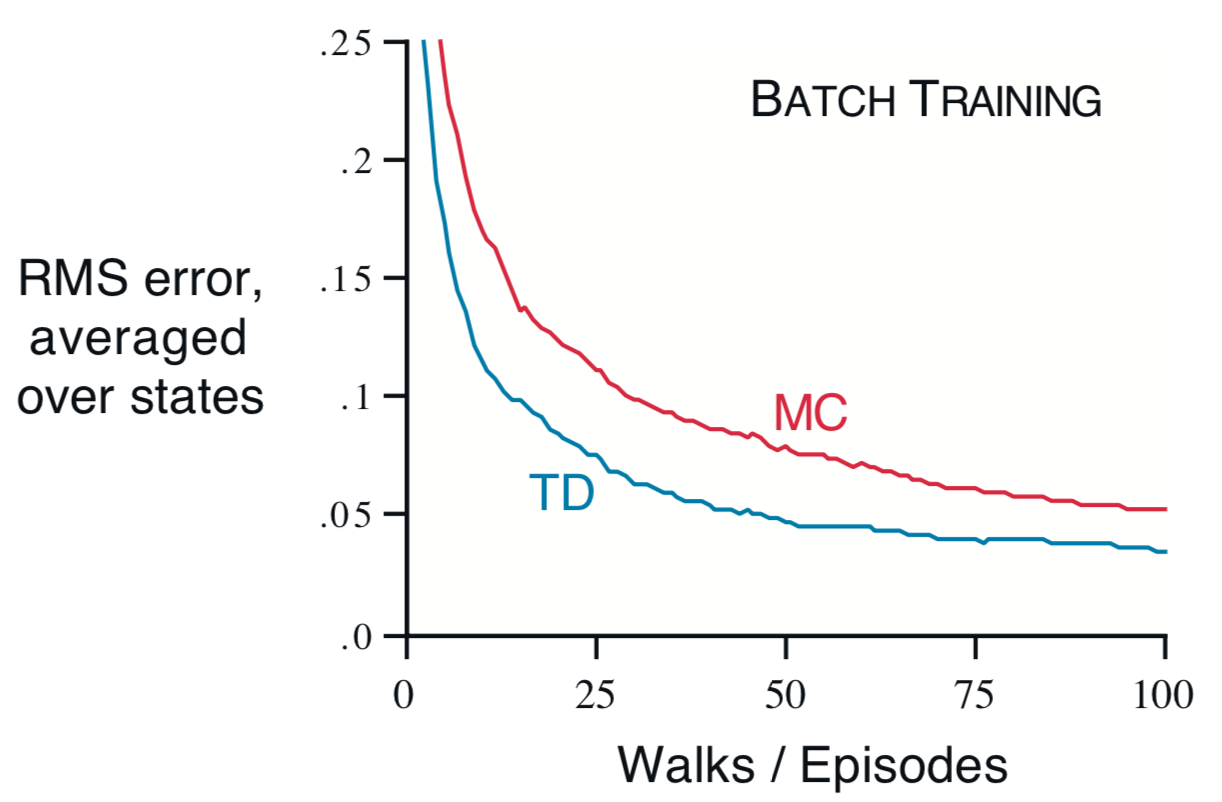
- MC averages actual returns and is optimal (minimizes MSE)
- How does TD perform better?
- TD is optimal in a way that is more relevant to predicting returns
Example 6.4
See example on page 127-128.
What answers do TD and MC give?
Optimality
- Batch MC minimizes MSE on training set
- Batch TD(0) performs ML estimation for Markov model
Certainty-Equivalence Estimate
Given observed episodes:
- \(\hat{p}(s'|s)\)=fraction of observed transitions
- \(\hat{v}_\pi(s)=V(s)\)=average of reward on those transitions
Batch TD(0) converges to the certainty-equivalent estimate (CEE)
Clues to Convergence
- Batch TD(0) faster than MC becuase of CEE
- Non-batch methods do not achieve CEE or MSE, they move in those directions, respectively
- Nonbatch TD(0) faster than constant-\(\alpha\) MC because it is moving toward a better estimate
Exercise & Homework
Start exercise 6.7 (page 128-129) in class and finish as homework.
SARSA: On-Policy TD Control
Background
- Control = Learning optimal policy
- GPI = Prediction (\(\pi_k \rightarrow v_k\)) + Improvement (\(v_k \rightarrow \pi_{k+1}\))
- Use TD methods for prediction
- Trade exploration and exploitation
- On-policy and off-policy
- State value and action value functions
Episode

- Previously considered \(s \rightarrow s'\) transitions and learned value \(v_\pi(s)\) of states
- Now consider \((s,a) \rightarrow (s',a')\) transitions and learn value \(q_\pi(s,a)\) of state-action pairs
SARSA Update
\[ \begin{align} Q(S_t,A_t) \leftarrow& Q(S_t,A_t) \\ &+ \alpha \left[ R_{t+1} + \gamma Q(S_{t+1},A_{t+1}) - Q(S_t,A_t)\right] \end{align} \]
- Update performed immediately after every transition from nonterminal state \(S_t\)
- \(Q(S_{t},A_{t})=0\) if \(S_t\) is terminal
- Uses quintuples \((S_t,A_t,R_{t+1},S_{t+1},A_{t+1})\)
SARSA Backup Diagram
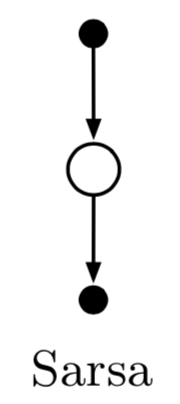
?
On-Policy SARSA Control
- Estimate \(q_\pi\) (prediction)
- Use \(q_\pi\) as behavior policy
- Change \(\pi\) toward greediness wrt \(q_\pi\) (control)
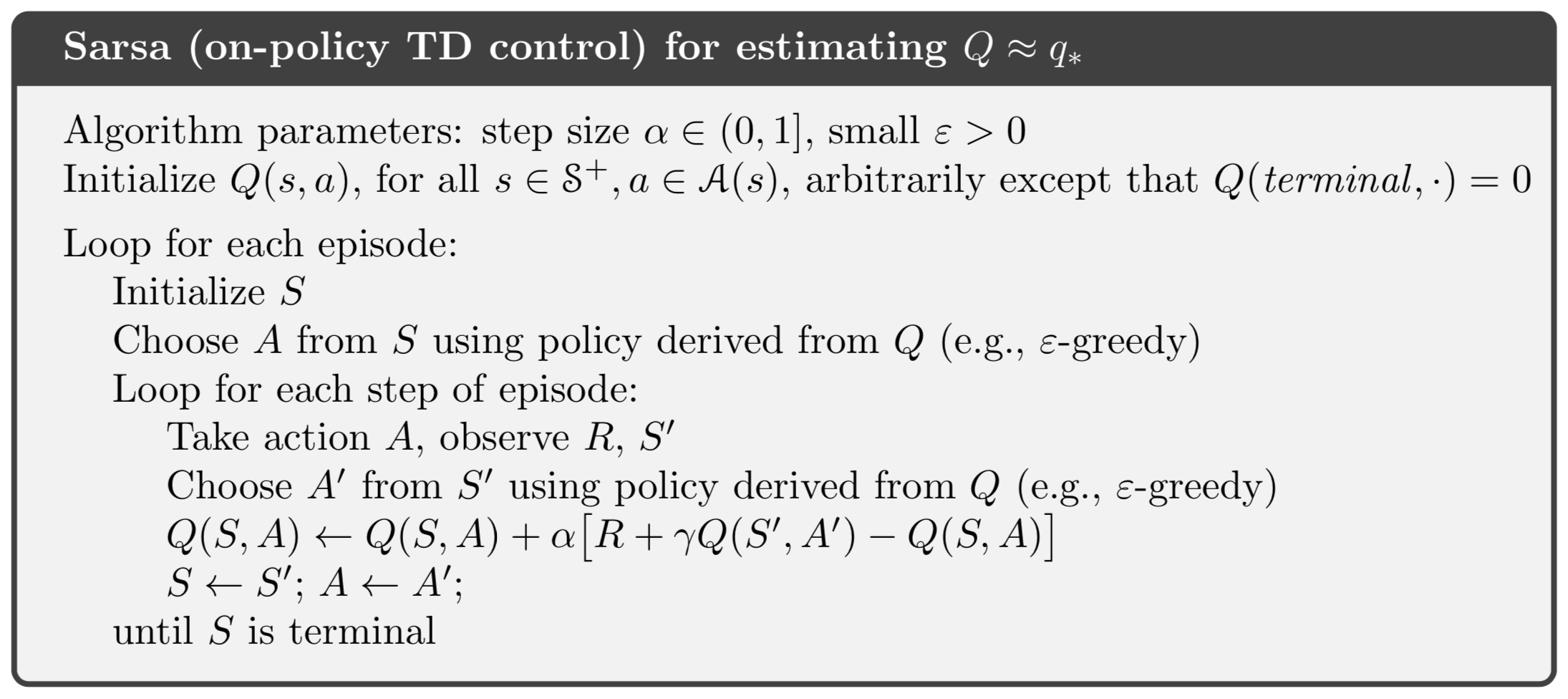
Convergence of SARSA Control
SARSA converges with prob. 1 to \(\pi_\ast\) provided:
- Policy \(\pi_k\) converges to greedy
- Use \(\varepsilon\)-greedy or \(\varepsilon\)-soft policies with \(\varepsilon = 1/t\)
- Assures all state-action pairs have infinite visits
Exercise 6.8
Do exercise 6.8 (page 129).
Example 6.5 Windy Gridworld
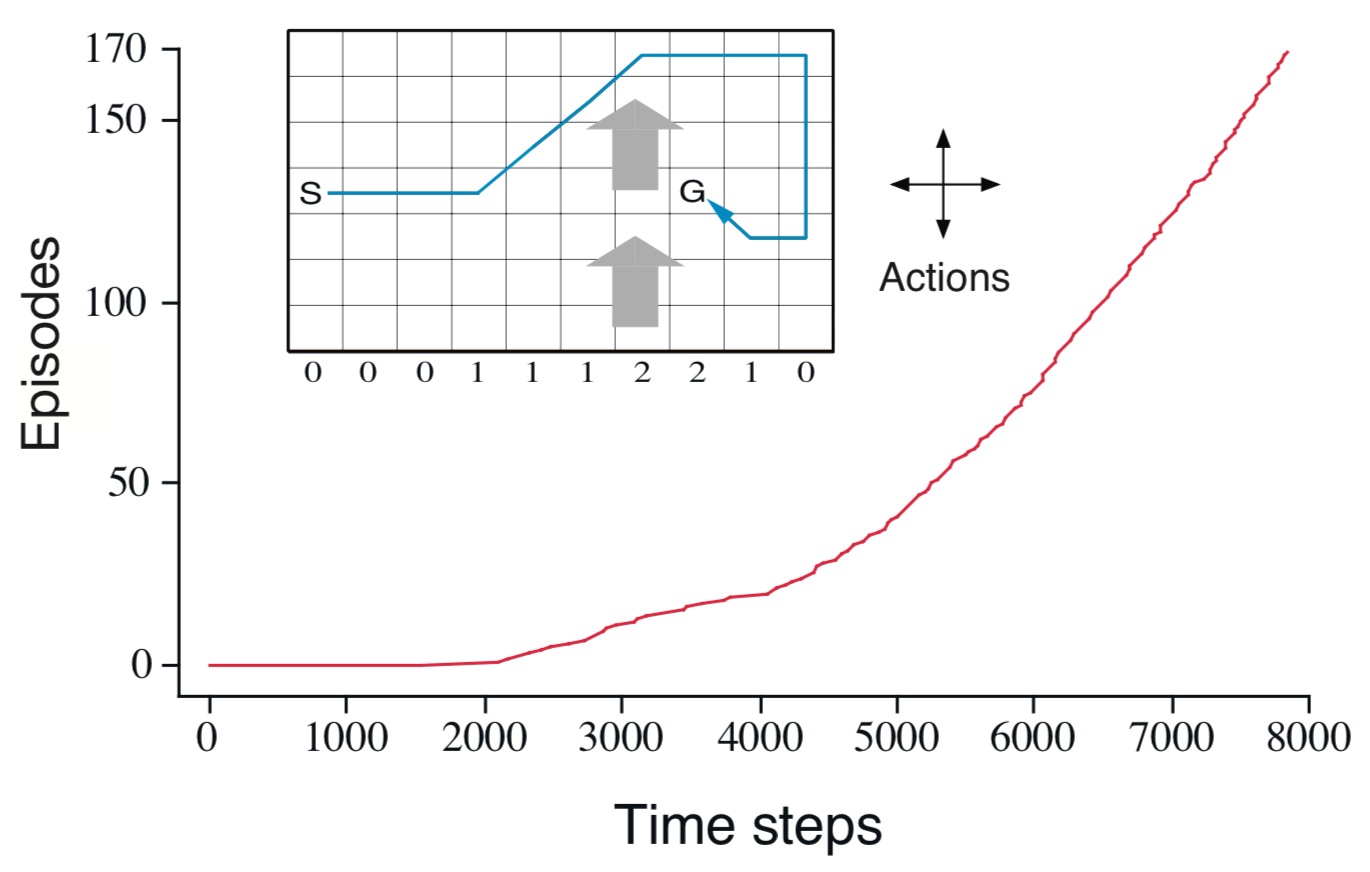
- Discuss example and performance curve
- How can MC fail for this problem?
- See code here
Homework
Do Exercises 6.9 and 6.10 (page 130-131).
Q-Learning
Q-Learning
Q-learning = Off-policy TD control
\[ \begin{align} Q(S_t,A_t) \leftarrow& Q(S_t,A_t) \\ &+ \alpha \left[ R_{t+1} + \gamma \max_{a'} Q(S_{t+1},a') - Q(S_t,A_t)\right] \end{align} \]
- Learned \(Q\) approximates \(q_\ast\) independent of behavior policy
- Behavior policy is \(\varepsilon\)-greedy
Convergence
Guaranteed with prob. 1 provide all state-action pairs are visited
Q-Learning Algorithm
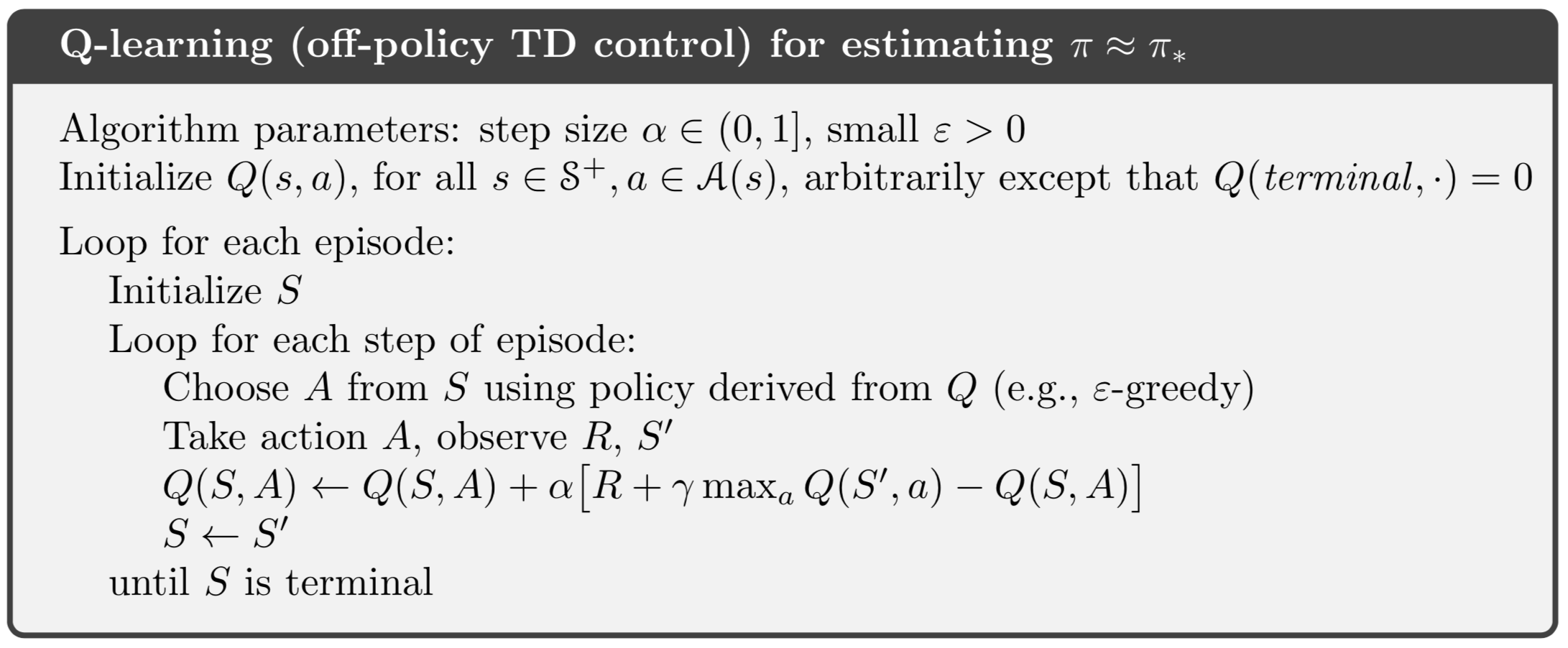
Why is this considered off-policy?
Backup Diagrams

Comparison
Compare the performance of SARSA and Q-learning in examples 6.6 (page 132).
Why does SARSA have better rewards?
Why does SARSA choose the safer path?
SARSA Control Algorithms
SARSA Control Algorithms
\[ \begin{alignat}{2} Q&(S_t,A_t) \leftarrow Q(S_t,A_t) + \alpha [R_{t+1} +& & \gamma \Phi - Q(S_t, A_t)] \\[1em] \Phi &= Q(S_{t+1},A_{t+1}) & & \text{SARSA}\\[1em] \Phi &= \max_{a'}Q(S_{t+1},a') & & \text{Q-learning}\\[1em] \Phi &= \sum_{a'} \pi(a'|S_{t+1})Q(S_{t+1},a') \;\;& & \text{Expected SARSA} \end{alignat} \]
Expected SARSA
\[ \begin{alignat}{2} \Phi &= Q(S_{t+1},A_{t+1}) & & \text{SARSA}\\[1em] \Phi &= \sum_{a'} \pi(a'|S_{t+1})Q(S_{t+1},a') \;\;& & \text{Expected SARSA} \end{alignat} \]
- E-SARSA moves deterministically in the same direction that SARSA moves in expectation
- E-SARSA has lower variance
- Given same amount of experience, E-SARSA should perform better
Comparison

Discussion
- Can do off-policy E-SARSA
- E-SARSA = Q-learning when target policy is greedy
- E-SARSA generalizes Q-learning
Maximization Bias
Q-Learning is Max. Biased

Why does Q-learning choose left (wrong choice)?
Maximization Bias
- Max of estimated value used as estimate of max of true value
- Max of estiamted value \(>\) max of true value (bias)
- Problem: same data used to determine max action and estimated value
- Solution: Split the data and have two value functions
Double Learning
\[ \begin{align} Q_1(S_t,A_t)&\leftarrow Q_1(S_t,A_t) + \alpha [ R_{t+1} \\ &+\gamma Q_2(S_{t+1},\arg \max_{a'} Q_1(S_{t+1},a')) \\ &- Q_1(S_t,A_t) ] \end{align} \]
Getting the value from \(Q_2\) of the greedy decision from \(Q_1\) to update \(Q_1\) eliminates maximization bias.
Double Learning Algorithm

Homework
- Add a learning curve for E-SARSA to Fig. 6.5 in example 6.7 (page 134-135)
- Do exercise 6.13 on page 136
Games & Afterstates
Tic-Tac-Toe
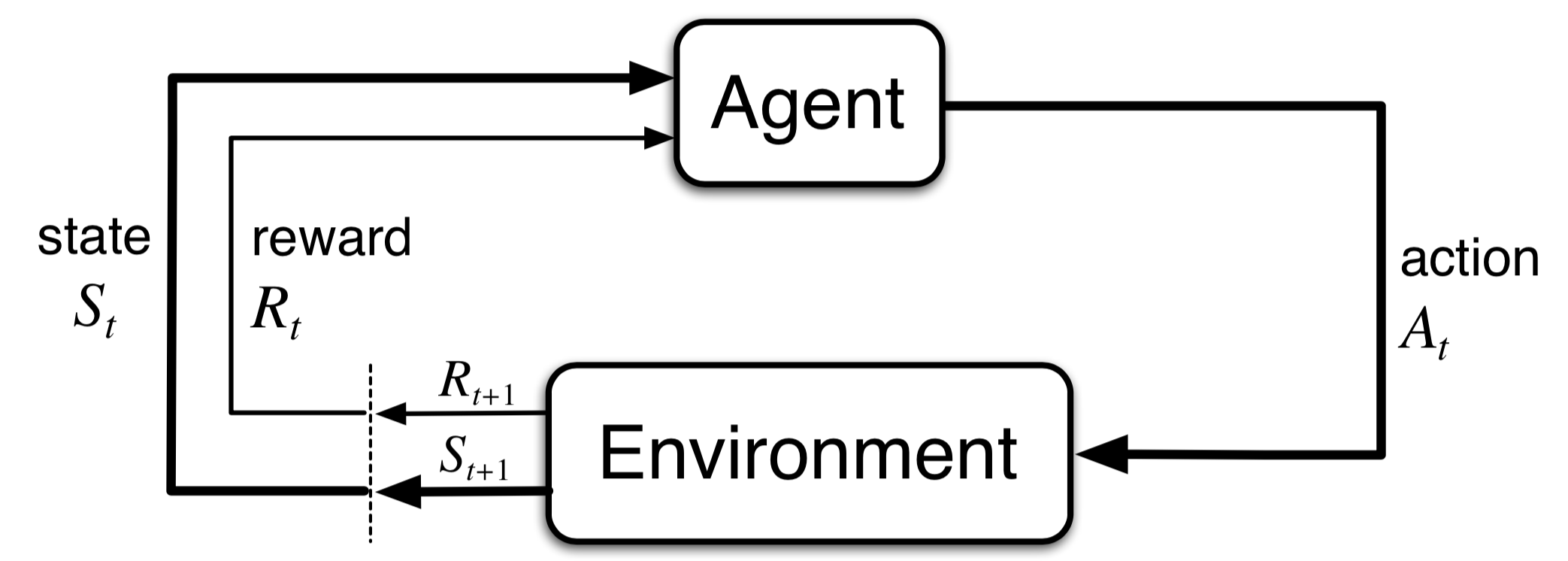
- Discuss tic-tac-toe in the agent-environment setting
- Discuss state vs. “afterstate”
- Discuss state-action vs. position-move
- Why is afterstate-value more efficient than action-value?